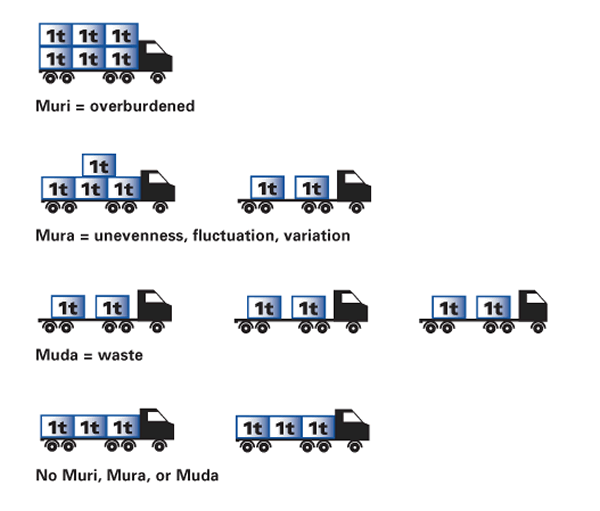Muda, Mura, Muri
Muda, Mura, and Muri are terms often used together in the Toyota Production System (and called the Three Ms) that collectively describe wasteful practices to be eliminated.
Muda
Any activity that consumes resources without creating value for the customer. Within this general category it is useful to distinguish between type one muda, consisting of activities that cannot be eliminated immediately, and type two muda, consisting of activities that can be eliminated quickly through kaizen.
An example of type one muda is a rework operation after a paintbooth, which is required to obtain a finish acceptable to the customer from a paint process that is not highly capable. Because a completely capable paint process for fine finishes has eluded manufacturers for decades, it is not likely that this type of muda can be eliminated quickly.
An example of type two muda is multiple movements of products and inventories between steps in a fabrication and assembly process. These steps can be quickly eliminated in a kaizen workshop by moving production equipment and operators into a smoothly flowing cell.
Mura
Unevenness in an operation; for example, a gyrating schedule not caused by end-consumer demand but rather by the production system, or an uneven work pace in an operation causing operators to hurry and then wait. Unevenness often can be eliminated by managers through level scheduling and careful attention to the pace of work.
Muri
Overburdening equipment or operators by requiring them to run at a higher or harder pace with more force and effort for a longer period of time than equipment designs and appropriate workforce management allow.
Muda, Mura, and Muri in Conjunction
A simple illustration shows how muda, mura, and muri often are related so that eliminating one also eliminates the others.
Suppose that a firm needs to transport six tons of material to its customer and is considering its options. One is to pile all six tons on one truck and make a single trip. But this would be muri because it would overburden the truck (rated for only three tons) leading to breakdowns, which also would lead to muda and mura.
A second option is to make two trips, one with four tons and the other with two. But this would be mura because the unevenness of materials arriving at the customer would create jam-ups on the receiving dock followed by too little work. This option also would create muri, because on one trip the truck still is overburdened, and muda as well, because the uneven pace of work would cause the waste of waiting by the customer’s receiving employees.
A third option is to load two tons on the truck and make three trips. But this would be muda, even if not mura and muri, because the truck would be only partially loaded on each trip.
The only way to eliminate muda, mura, and muri is to load the truck with three tons (its rated capacity) and make two trips.
